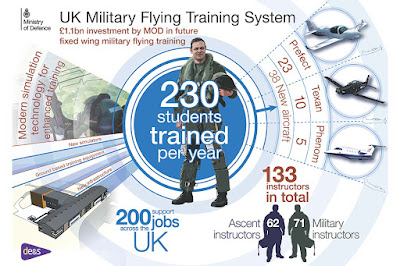Finally we have the announcement for the renewal of the fixed wing training fleets and of the whole training pipeline and system, which will see all passages of training moving under UK Military Flight Training System mechanisms.
The announcement carefully avoids mentioning the expected transfer of Basic Training from RAF Linton-on-Ouse to RAF Valley. It looks pretty likely to me that Linton will close as a consequence, but there seems to be no hurry in mentioning the possibility.
The SDSR 2015 factsheet promises to expand the training fleet to enable the training of enough crews for running the fleets of aircraft that are promised for the future. Some evidence of this is present in today's announcement, as it provides a considerably higher number of military and civilian instructors than was expected earlier.
There will now be 71 military instructors, rather than 64, and 62 civilian instructors, up from 34.
 |
| Pre SDSR 2015 numbers of the UKMFTS Fixed Wing plan |
Unfortunately, though, the number of aircraft is completely unchanged, and the three new fleets will still be tiny:
Just 23 Grob G120TP – to be known as “Prefect” once in service – will replace the Grob G115 Tutors.
Just 10 T-6C Texan will replace the Short Tucano T1s, while just 5 Embraer Phenom 100 will replace the existing Beechcraft King Air 200s.
 |
| The numbers of UKMFTS Fixed Wing as announced 2 february 2016 |
For now at least, this means no increase at all from pre-SDSR expectations, despite the considerably larger RAF promised by the SDSR. Even with the expected increase in the use of simulation, with large reductions to actual flying hours required for training, it is questionable whether these small numbers can suffice.
They will also continue to make it hard / impossible to train foreign students, something the NAO already warned about.
The MOD is providing, as always, zero details about what happens next. However, the RAF is understood to be planning for a new "Military Flying Training School" in RAF Valley, which is expected to, effectively, absorn the current No 4 and No 1 FTSs.
The tiny fleets ahead suggests that the number of squadrons will drop. 208 Sqn, flying Hawk T1, is already planning and executing its sundown phase, connected with the progressive passage to a T2-only training pipeline (even while the Hawk T1 continues to equip 100 Sqn RAF, Red Arrows and 736 NAS).
72(R) Sqn might or might not carry on. It might move to RAF Valley and re-equip with the Texan, or it might disband, replaced by a different squadron. Perhaps 208 itself.
Elementary Flying Training squadrons might also become fewer. Currently, the force includs:
-
16(R) Squadron – RAF Wittering: one of two
Squadrons providing elementary flying training to future Royal Air Force
pilots, including basic airmanship, navigation and aircraft handling skills.
Upon completion, successful pilots are then streamed into advanced training
programmes; fast jet, multi-engine or rotary wing.
-
57(R) Squadron – RAF Cranwell: one of two
Squadrons providing elementary flying training to future Royal Air Force
pilots, including basic airmanship, navigation and aircraft handling skills.
Upon completion, successful pilots are then streamed into advanced training
programmes; fast jet, multi-engine or rotary wing.
-
115 (R) Squadron – RAF Wittering: is responsible for
the training of new Qualified Flying instructors, and the provision of refresher
training for previously qualified instructor.
Meanwhile, there are reports that 100 Sqn RAF will up its game by swapping the Hawk T1 for the Typhoon, to form a more capable "Red Air" squadron to support training. We don't have any official confirmation yet, nor any detail of how it will be done.
It has been suggested to me that 100 Sqn might end up having only crews, sent to Coningsby to pick up aircraft only when needed.
On the other hand, after the SDSR, the Chief of the Air Staff Air Chief Marshal Sir Andrew Pulford said that they had a plan to try and obtain "a third fast jet squadron" over and above the 2 promised by the SDSR, to reach a total of 10. Putting Typhoon in 100 Sqn could achieve that aim.
It'll be one to watch, and it clearly depends on how many Typhoon tranche 1 stay in service, and for how long.
On the helicopter front, the 8 Bell 212 helicopters used in support to training have a 2017 Out of Service Date.
It is now being reported that the MOD is looking to out-source the helicopter support for the Brunei garrison (7 Flight AAC), which uses Bell 212s.
The Bell is also used by 25 Flight in Kenya (BATUK) and is also associated to use in Belize, where the flight was based until after the SDSR 2010. With Belize seeing a return of british troops for training, there is probably scope for a single helicopter type to replace the 212 in all three locations, but for now it seems that the initiative is limited to Brunei.
Within the next few months, the renewal of the Rotary Wing training fleets and pipeline is also expected to progress. Further announcements can thus be expected.